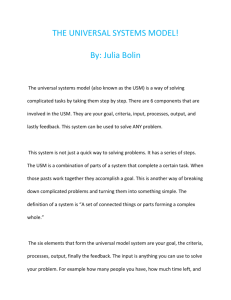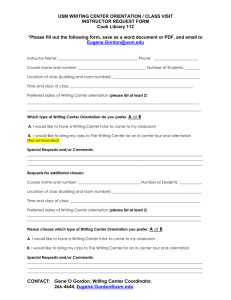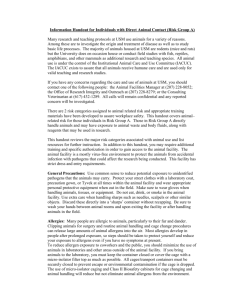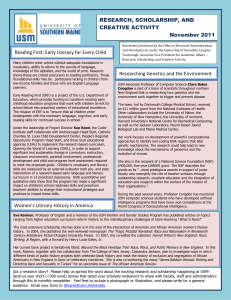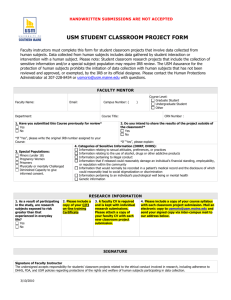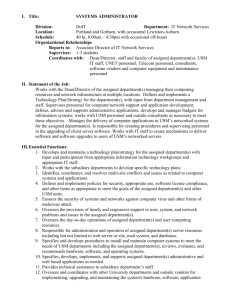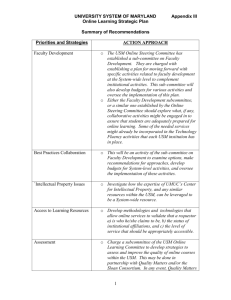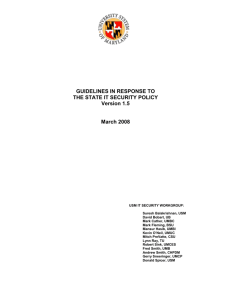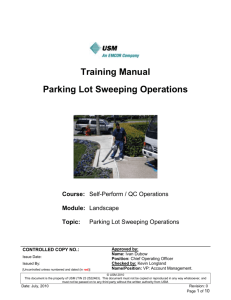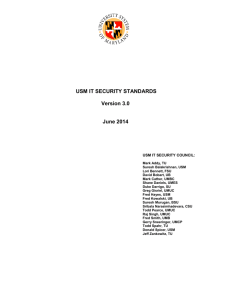Occupational Health & Safety Program
advertisement
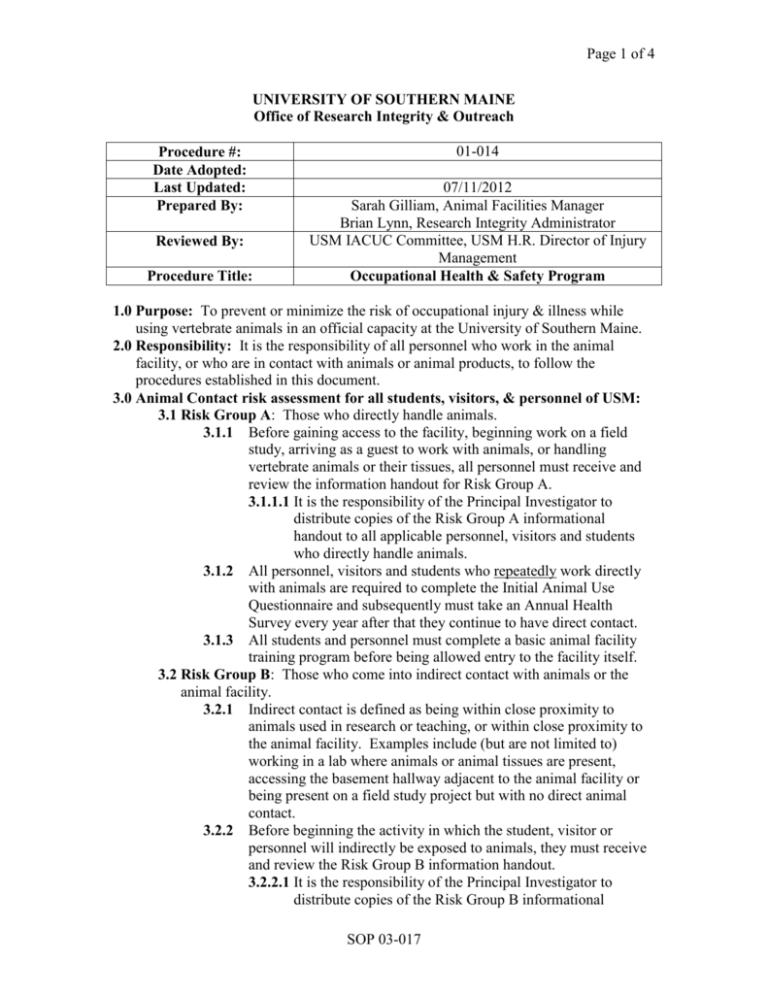
Page 1 of 4 UNIVERSITY OF SOUTHERN MAINE Office of Research Integrity & Outreach Procedure #: Date Adopted: Last Updated: Prepared By: Reviewed By: Procedure Title: 01-014 07/11/2012 Sarah Gilliam, Animal Facilities Manager Brian Lynn, Research Integrity Administrator USM IACUC Committee, USM H.R. Director of Injury Management Occupational Health & Safety Program 1.0 Purpose: To prevent or minimize the risk of occupational injury & illness while using vertebrate animals in an official capacity at the University of Southern Maine. 2.0 Responsibility: It is the responsibility of all personnel who work in the animal facility, or who are in contact with animals or animal products, to follow the procedures established in this document. 3.0 Animal Contact risk assessment for all students, visitors, & personnel of USM: 3.1 Risk Group A: Those who directly handle animals. 3.1.1 Before gaining access to the facility, beginning work on a field study, arriving as a guest to work with animals, or handling vertebrate animals or their tissues, all personnel must receive and review the information handout for Risk Group A. 3.1.1.1 It is the responsibility of the Principal Investigator to distribute copies of the Risk Group A informational handout to all applicable personnel, visitors and students who directly handle animals. 3.1.2 All personnel, visitors and students who repeatedly work directly with animals are required to complete the Initial Animal Use Questionnaire and subsequently must take an Annual Health Survey every year after that they continue to have direct contact. 3.1.3 All students and personnel must complete a basic animal facility training program before being allowed entry to the facility itself. 3.2 Risk Group B: Those who come into indirect contact with animals or the animal facility. 3.2.1 Indirect contact is defined as being within close proximity to animals used in research or teaching, or within close proximity to the animal facility. Examples include (but are not limited to) working in a lab where animals or animal tissues are present, accessing the basement hallway adjacent to the animal facility or being present on a field study project but with no direct animal contact. 3.2.2 Before beginning the activity in which the student, visitor or personnel will indirectly be exposed to animals, they must receive and review the Risk Group B information handout. 3.2.2.1 It is the responsibility of the Principal Investigator to distribute copies of the Risk Group B informational SOP 03-017 Page 2 of 4 handout to all applicable personnel, visitors and students who will indirectly be exposed to animals or their tissues. 3.2.3 It is the responsibility of individual personnel, visitors or students to notify the University Environmental Health and Safety Office if they have any known animal allergies, or if an injury or allergy occurs while using animals. 4.0 Animal Facility Known Hazards: All personnel who are to gain entry to the animal facility shall have orientation training that will include the hazards associated with working in an animal facility. 4.1 Biological: 4.1.1 Zoonotic diseases 4.1.1.1 A list of zoonotic diseases will be posted on each animal room door. 4.1.1.2 Animal screening will occur at the vendor level before the animals will be allowed into the animal facility. 4.2 Chemical: All chemicals shall be labeled appropriately and Material Safety Data Sheets (MSDS) for all chemicals will be placed in an accessible area of the facility. 4.2.1 Bleach 4.2.2 Anesthetic gases 4.2.3 Disinfectants 4.2.4 Cleaners/Detergents 4.2.5 Tissue fixatives 4.2.6 Pesticides & fungicides 4.2.7 Lab chemicals involved in individual projects 4.2.7.1 Material Safety Data Sheets (MSDS) provided to the animal facility by the Principal Investigator. 4.3 Physical: 4.3.1 Machinery (autoclave, cage washer) 4.3.2 Animal bites or scratches 4.3.3 Sharps (needles, scalpels) 4.3.4 Lighting (UV, low light levels) 4.3.5 Gas cylinders 4.3.6 Electricity 4.3.7 Noise (resulting from machinery, loud animals) 4.3.8 Radiation 4.3.9 Ergonomics (lifting, loading) 4.3.10 Animal allergens 4.4 Protocol related: 4.4.1 Infectious agents 4.4.1.1 The investigator shall provide the following information to the animal facilities manager: 4.4.1.1.1 Virulence, communicability, routes of exposure, shedding patterns, prevalence, and availability of prophylaxis and therapy 4.4.1.2 Before being used, the agent must be approved by IACUC and the Biosafety Committee and be assigned an Animal Biosafety Level (ABL). SOP 03-017 Page 3 of 4 4.4.1.3 Requirements and ABL assigned to a project will be posted and followed accordingly. 4.4.1.3.1 A sign will be posted that will list the agent, the ABL assigned, the necessary precautions, and the emergency contact personnel. 4.4.1.3.2 Entry into these rooms will be restricted to essential personnel only. 5.0 Orientation 5.1 Pre-placement 5.1.1 Employee or student must have a current Tetanus immunization. 5.1.1.1 Documentation of immunization should be provided to University Environmental Safety & Health. 5.1.1.2 Vaccination needs to be updated every 10 years. 5.1.2 Medical history for those with repeated and substantial direct contact with animals (ex-allergies, asthma, etc.) 5.1.2.1 History is taken via the Animal Use Questionnaire. 5.1.3 All personnel will receive a corresponding handout outlining the animal-related risk associated with their job depending on their assigned risk group. 5.2 During employment 5.2.1 Monitoring of employee’s physical health 5.2.1.1 For those working directly with the animals, this will be done via an annual health status questionnaire. 5.3 Education and Training 5.3.1 Training prior to entering animal facility 5.3.1.1 Includes identification and avoidance of potential hazards, incident procedure, and personal protective equipment. 5.3.2 Personnel will be given an informational handout that specifies the anticipated risks associated with their direct or indirect contact with animals. This document also includes the contact information for the appropriate offices at USM. 5.3.2.1 Personnel are expected to read this informational handout thoroughly and to contact University Environmental Health and Safety if they have any pre-existing medical conditions. 5.3.3 Additional training available as needed 5.3.3.1 Includes available consultation with other staff members. 5.4 Appropriate job descriptions or classifications will be assigned to individual positions. 6.0 Injury reporting 6.1 In an emergency situation, emergency services are to be called immediately by dialing 911. 6.2 Injuries of a non-emergency nature can be treated: 6.2.1 On premises via first aid, or 6.2.2 At Bayside Employee Health if the injury is to a USM employee (includes student-workers), or 6.2.3 At the USM Student Health Services office or by primary care physician if the injury is to a student SOP 03-017 Page 4 of 4 6.3 If any employee or student is injured, the USM Police must be called, and the following forms must be filled out: 6.3.1 Human Resources Injury Report 6.3.1.1 Original will be faxed to and filed with the Injury Management Office as soon as possible. 6.3.2 University Environmental Health and Safety Personal Injury Report for Animal Incidents 6.3.2.1 A copy of the original should be given to the animal facilities manager as well as to University Environmental Safety & Health. 6.3.3 University Environmental Health and Safety Bloodborne Pathogen Incident Form 6.3.3.1 A copy of the original should be given to the animal facilities manager as well as to University Environmental Safety & Health. 6.4 Emergency Equipment on premises: 6.4.1 First Aid Kit, including burn treatment. 6.4.2 Fire extinguisher 6.4.3 Emergency shower 6.4.4 Eye Wash Station 7.0 Monitoring of injuries 7.1 Listing of all injuries kept on file by the Benefits Office within the Office of Human Resources. 7.2 Injuries and incidents will be reported to IACUC. 7.3 USM’s University Environmental Health & Safety Office, in accordance with OSHA regulations, keeps records on all injuries. The Benefits Office within Human Resources also maintains these records. SOP 03-017
